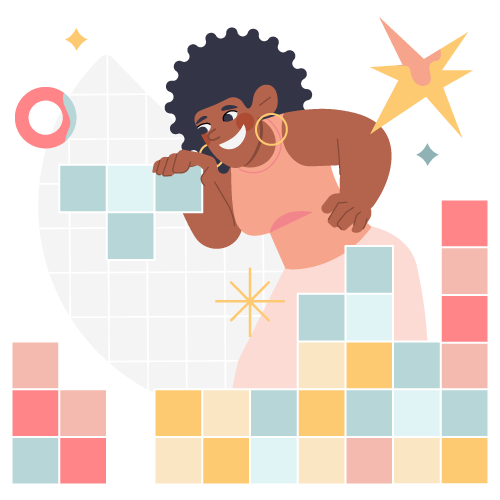Albert Einstein famously said, “If you can’t explain it to a six-year-old, you don’t understand it yourself.” This quote is at the heart of teaching: whether your concept is theoretical physics or how to sell more products, breaking it down into simple, understandable components makes all the difference for engagement and retention. And how do you engage a six-year-old? A sixty-year-old? One of the best tools (for all ages) in our engagement arsenal is animation.
Animation, when used thoughtfully and intentionally, is a powerful tool for teaching complex concepts in deceptively simple, engaging ways, no matter how old your audience. When building eLearning courses, animation is one of the first things we brainstorm—that’s because we know it works. Not sure if it’s right for your eLearning content strategy? Here’s how animation can work for you.
What is animation in eLearning?
By definition, animation is a process of creating the illusion of motion in objects that would normally be static, done for the purpose of telling a story or providing a moving visual to direct the audience’s attention. The history of animation in learning surprisingly dates back over 2000 years, most notably with Chinese and Indonesian shadow puppets used to entertain and instruct through parables, fables, and cautionary tales. Animation has always been used as a method of showing, rather than telling.
In the 20th century, after the invention of animated film, video animation as an instructional tool was impossible for the lay educator, as it had to be hand-drawn and filmed. Therefore, it was usually reserved strictly for entertainment. Until animation was aided by the home computer (most notably with MS PowerPoint in the early ‘90s), animation as a teaching tool was rare. PowerPoint made animation more accessible to teachers and business people alike, even if it wasn’t fancy or particularly stylish.
Of course, now we have multitudes of cloud-based, free, or subscription-based applications like Motion, Adobe After Effects, GoAnimate, Prezi, VideoScribe, and ToonBoom.
Animated videos in eLearning are used to explain a concept, market or sell a product by engaging and convincing, or demonstrate a method in technical training. And, thanks to an ever-evolving world of graphic design, animations are easier than ever to create and deploy as part of your eLearning content.
When applied to instructional design, animations catch the eye, direct focus, and help fill your learners with the good vibes they need to stay engaged from start to finish.
The benefits of using animation in eLearning
An animation in eLearning is best used with intention and intelligence, as it can be distracting, overwhelming, or superfluous if not used correctly. You don’t want to insert it solely to liven up an otherwise dull presentation or when it complicates the subject matter rather than breaking it down. Basically, don’t rely on animation to fix lackluster content but to enhance your best work.
Here are some of the reasons why we at ELM make use of video animation in most of our eLearning courses.
- Animation helps explain abstract concepts. Not all learning is as simple as step one and step two. Sometimes, abstract concepts (think communication or leadership skills) aren’t a linear process. We love using animation as a way to demonstrate different behaviors and outcomes so learners can follow them in a safe and engaging space before testing the waters in real life.
- Animation engages the brain. When your brain experiences more than one sense at a time, it releases feel-good hormones like endorphins, oxytocin, and dopamine. All of these hormones are necessary to really connect with content and animation. Animation directs focus, introduces characters and storylines, and utilizes sound and humor—creating a multi-sensory experience for your learners. Rather than skipping over words on a page, learners are more likely to engage with and absorb the content.
- Animation improves retention. Brains are extremely efficient: Whether you realize it or not, your brain is constantly making in-the-moment decisions on what information to keep and what to discard. When it receives too much information via one delivery method (reading text, for example) it can only process and store so much data before it starts to sort it into the discard pile. Animation is unique because it reduces the cognitive load on your brain. In demonstrating a new process, animation helps tell your brain what’s important and which key things to remember.
- Animation improves learner attitude. Imagine you’re watching TV and a commercial begins. Which would you pay more attention to: a talking head interview or an entertaining cartoon? It could be for the exact same product, but animation captures your attention and might even engender more positive feelings toward whatever’s being sold. We get it—not all eLearning content is created equally and, if they’ve been burned by boring training in the past, learners might already feel checked out long before they even experience something new. Animation is a great way to improve learner attitudes and invest in engaging in a new, fresh way.
- Animation makes content more diverse. Video and photo images can definitely help spice up lackluster learning, but they have their limitations. We love animations for creating eLearning courses that are inclusive and diverse. By utilizing abstract characters and storylines, animation allows us to create scenarios that everyone can see themselves in. Users can choose their own avatars or we can create characters that feel familiar, no matter the learner’s culture, language, gender, or role.
- Animation is a natural fit for storytelling and metaphors. Hands down, storytelling is one of the most effective ways of knowledge transfer. When you use stories and metaphors to teach, suddenly your eLearning content is contextualized in a recognizable way. eLearning animation is a natural fit for telling these stories; we show the characters going through their journey and show the outcomes so learners really connect with the content.
Four ways we use animation at ELM Learning
At ELM Learning, we use our unique animation style to bring your eLearning content to life. In our opinion, animation works best for almost all types of learning and delivery methods. Creating custom animations means we’re able to design smart, beautiful eLearning courses that engage and inspire. We’ve used animation in just about every application imaginable, but here are some of our favorite ways to use it for eLearning.
- Explainer videos: Whenever you need to explain something, showing is always superior to telling. We create beautifully animated, branded videos for our clients so they can show and tell their customers who they are and what they do. Explainer videos are also ideal for launching new courses and strategies since they help to capture attention and help the learner understand what’s in it for them.
- Marketing videos: We call these “hearts and minds” videos, as they are designed to inspire internal and external stakeholders. We use animations to create a bond between the user and the content. It creates trust and appeals to their emotions, so they bond with the content. We create animated videos to help different departments convey new ideas to employees, communicate tough messages that speak to their hearts and minds (particularly as a change-management tool), and as intros to new products, processes, and training. We also create animated videos for our clients to help convey a message to their customers or explain how to use a product or service.
- Learning videos: These are our custom-created learning solutions that combine visual storytelling and smart design to create sustained engagement, better recall, and dare we say, fun in each learning experience. As an eLearning company, we believe that your ROI is only as good as your content, and animation helps organizations see the most benefits in capturing attention, inspiring change, and improving information recall.
- Tech training: In technical training, it’s necessary to control and stage the environment in order to create specific scenarios. Therefore, an animation is the ideal visual representation for a technical process or methodology. With animated tech-training videos, you can lead your audience through any type of scenario and precisely demonstrate objective outcomes. Tech training works best when it’s both specific and clear, so we create eLearning animation that is hyper-relevant and easy for users to understand and apply.
Final Thoughts
We like to think we’re doing Einstein proud: creating animations that appeal and explain to anyone, regardless of their age, background, or roles. Our animation style is heavily customized based on the project, but it’s always a team effort that rejuvenates our clients’ eLearning strategy and content. Whether it’s informing about a new product or training learners on a new piece of software, animation helps us all picture learning experience design in a fresh way.






